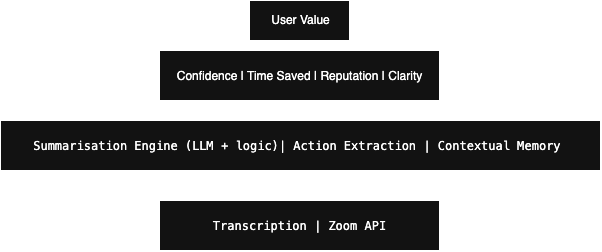No One Cares About Your AI Feature Until It Saves Time, Money, or Embarrassment
LLMs Don’t Impress Me - They Need to Earn Their Keep
A few months ago, I shipped a product feature that had me feeling like Iron Man.
LLM-powered. Smart. Slick.
It listened in on Zoom calls, transcribed meetings in real-time, pulled out action items, and even drafted follow-up emails based on who said what.
It felt like magic.
It worked.
It was clever.
And… nobody cared.
The feedback was humbling: “Cool, but I already use Google Docs.”
“I still double-check the transcript.”
“Not sure I need this.”
And that was it.
I sat there - quite tired, caffeinated, slightly offended - wondering how something that smart could feel so… forgettable.
That’s when I realised something I wish I had known earlier:
People don’t care about AI. They care about what hurts.
They care about time they can’t get back.
Money they can’t afford to lose.
Situations where they look unprepared, forgetful, or foolish.
AI? That’s just plumbing.
Let’s take a closer look.
Imagine a fictional app called Meetwise: an AI meeting assistant.
Here’s what we thought we built:
User joins Zoom → Audio transcribed → LLM parses content →
Custom prompts run:
→ Summary
→ Action Items
→ Follow-up Emails →
Synced to Slack / Notion / Email →
Done.Sounds impressive, right?
But here’s what actually matters to the user:
User joins Zoom → Feels less pressure to take notes → Feels present during conversation → Meeting ends →
Gets a clean summary:
→ What they promised
→ What others owe them
→ What will make them look sharp in the next call →
They feel calm. In control. Competent.That’s what we were really selling.
Not AI.
Not automation.
Not “cutting-edge LLMs.”
We were selling relief. Reputation. Time.
The Diagram I Wish I’d Drawn Earlier
The user never sees it.
And truthfully? They don’t care to.
They care that they didn’t forget that one task.
That they looked sharp in front of the CEO.
That they got their time back.
Before You Ship Your Next AI Feature…
Ask yourself three simple questions:
Does it save someone time?
Does it save or make money?
Does it protect people from looking foolish, unprepared, or overwhelmed?
If the answer is no, it might be technically cool, but emotionally irrelevant.
And if your product doesn’t feel like it solved a pain, it didn’t solve anything.
The Real KPI of an AI Feature?
Time saved, Money earned or protected, Embarrassment avoided
If it doesn’t hit one of those?
It’s a demo, not a product.
So, here are my final thoughts:
AI is the hammer.
But the nail still matters.
If you want to build something people use, and love — don’t start with “We use AI.”
Start with:
“We help you avoid missing the one thing you’ll regret later.”
That’s a story people remember.
And that’s what people pay for.
I’d love to hear from you, what’s the best (or worst) AI feature you’ve seen lately?
And what problem did it actually solve?
Drop a comment or share this with the one friend still pitching “AI for vibes.”
If this resonated and you’re building something real in the AI space, or just tired of fluff - follow me.
I write for founders, engineers, and builders trying to create value, not just features.



